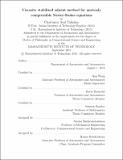Viscosity stabilized adjoint method for unsteady compressible Navier-Stokes equations
Author(s)
Talnikar, Chaitanya Anil.
Download1084479705-MIT.pdf (26.03Mb)
Other Contributors
Massachusetts Institute of Technology. Department of Aeronautics and Astronautics.
Advisor
Qiqi Wang.
Terms of use
Metadata
Show full item recordAbstract
Design optimization methods are a popular tool in computational fluid dynamics for designing components or finalizing the flow parameters of a system. The adjoint method accelerates the design process by providing gradients of the design objective with respect to the system parameters. But, typically, adjoint-based design optimization methods have used low fidelity simulations like Reynolds Averaged Navier-Stokes (RANS). To reliably capture the complex flow phenomena like turbulent boundary layers, turbulent wakes and fluid separation involved in high Reynolds number flows, high fidelity simulations like large eddy simulation (LES) are required. Unfortunately, due to the chaotic dynamics of turbulence, the adjoint method for LES diverges and produces incorrect gradients. In this thesis, the adjoint method for unsteady flow equations is modified by adding artificial viscosity to the adjoint equations. The additional viscosity stabilizes the adjoint solution and maintains reasonable accuracy of the gradients obtained from it. The accuracy of the method is assessed on multiple turbulent flow problems, including subsonic flow over a cylinder and transonic flow over a gas turbine vane. The utility of the method is then tested in performing shape optimization of the trailing edge of a transonic turbine vane. The optimal design, found using a modified gradient-based Bayesian optimization algorithm, shows approximately 15% better aero-thermal performance than the baseline design. Such design optimizations are possible due to the availability of massively parallel supercomputers. Designing high performance fluid flow solvers for the next generation supercomputers is a challenging task. In this thesis, a two-level computational graph method for writing optimized distributed flow solvers on heterogeneous architectures is presented. A checkpoint-based automatic differentiation method is used to derive the corresponding adjoint flow solver in this framework.
Description
This electronic version was submitted by the student author. The certified thesis is available in the Institute Archives and Special Collections. Thesis: Ph. D. in Computational Science and Engineering, Massachusetts Institute of Technology, Department of Aeronautics and Astronautics, 2018 Cataloged from PDF version of thesis. Includes bibliographical references (pages 187-195).
Date issued
2018Department
Massachusetts Institute of Technology. Department of Aeronautics and AstronauticsPublisher
Massachusetts Institute of Technology
Keywords
Aeronautics and Astronautics.